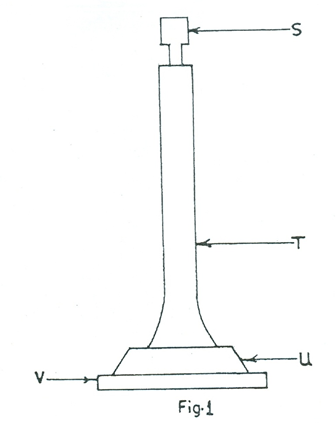Section A
Question 1
Answer question 1 which is compulsory and any other question from this section.

(1)
(a)
(i) Identify the sketch shown in Fig. 1
(ii) Name the parts labelled S, T. U and V.
(iii) State two functions of the component identified in 1(a)(i).
(b) State one function each of the following hydraulic brake system components:
- master cylinder;
- servo unit;
- reservoir;
- flexible pipes;
- steel pipelines.
Observation
This compulsory question was well attempted by most of the candidates as they were able to give the required response to part (a) of the question. Part (b) of the question was poorly answered. The required response to part (b) is as follows:
(b) Functions of the hydraulic brake system components
- Master Cylinder:
- This component enables the transfer of the driver’s
foot pedal force to each brake unit through the hydraulic fluid.
- It converts the pedal force into fluid pressure.
- The master cylinder also forces the fluid along the pipe to the wheels.
- Servo Unit:
- This assists the driver’s effort when applying the brakes
- The servo-unit reduces the driver’s effort during the application of the brakes.
- Reservoir:
- This contains a reserved quantity of hydraulic brake fluid.
- It is used to store hydraulic fluid.
- It is a storage tank for brake fluid.
- Flexible Pipe:
- It creates a flexible connection between the steel pipe and the wheels.
- It allows for flexibility in the system to allow the wheels to move in relation to the car body.
- Steel Pipe Lines:
- Connects the components in the hydraulic system.
- It transmits hydraulic pressure to the wheel brakes with the assistance of the brake fluid.
- It transmits the pressure generated by the master cylinder to the brake regulating system without delay.
